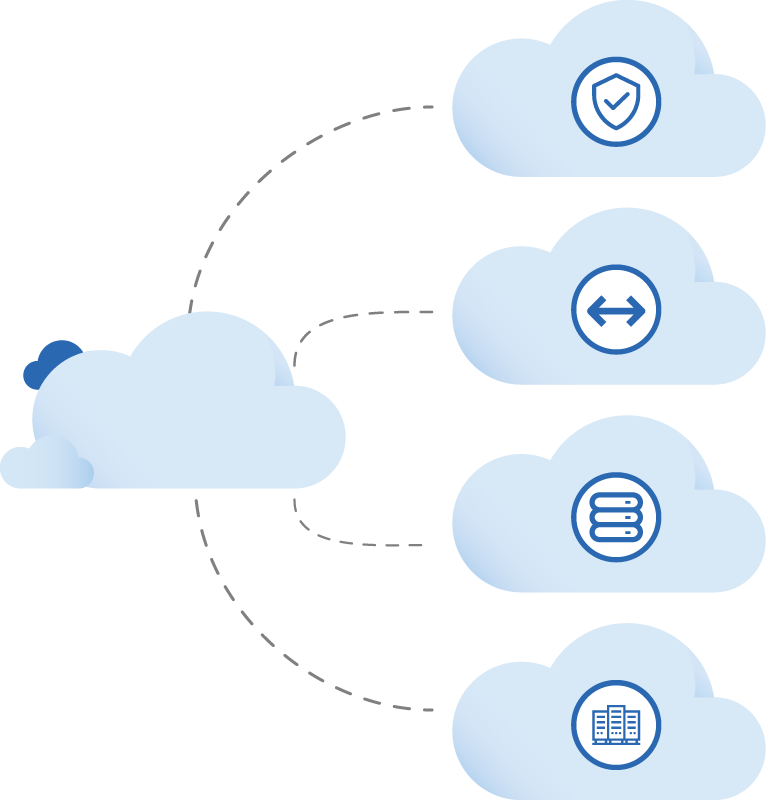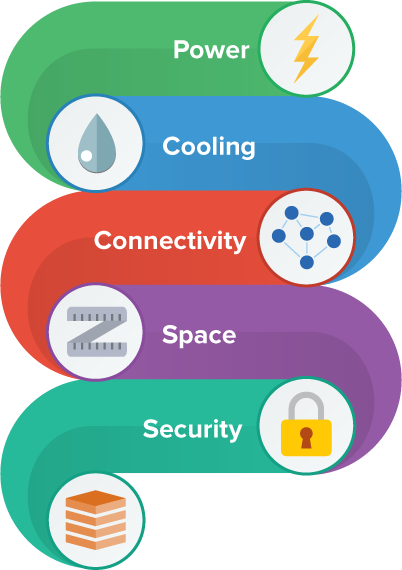The Cloud is more than remote IT infrastructure. Most clouds combine virtual off-site, aka public cloud, and on-premises hardware. This combination is known as hybrid cloud. On-premises infrastructure can be in-office, in a company owned and operated data center or colocated into an independently owned and managed data center. Colocation is the smart choice for hosting owned IT assets. It has the most agile combination of the proper environment with connectivity, scalability, redundancies and cost effectiveness.
Forecast is Cloudy
There are plenty of reasons to operate in the cloud: quick setup, consume only what you need, pay only for what you use as an OPEX price model, and scale fast. It is no wonder cloud computing has become ubiquitous. 96 percent of companies use one or more cloud providers.
Startups run almost exclusively in the cloud. After coming up with a compelling product idea and a cool brand name, their next big decision is usually whether to use Amazon Web Services, Microsoft Azure or Google Cloud.
Private, Hybrid and
Multi-Cloud Solutions
- Flexible Build to Suit Options
- Custom Built Servers
- Cloud Provider Connectivity
- Infrastructure Colocation
Enterprise companies like the cloud too. In 2016 Microsoft disclosed that 90 percent of the Fortune 500 use Azure.
Hardware: It’s Here to Stay
While multi-tenant cloud adoption continues to grow, traditional IT infrastructure still plays an important role. Most public cloud users synchronize data between their cloud and on-premises technology. The reasons are numerous. For example, many organizations have legacy applications that cannot function in the cloud. Or, financial companies often require security compliance assurances and extreme bandwidth speeds. Also, while cloud costs continue to drop, cloud pricing can be far more expensive than operating owned hardware, especially for high-volume or high-density computing.

The Hybrid Cloud
Data should not exist in a silo, cut-off from the rest of your organization. Marketing applications ought to communicate with sales software. Shopping carts should pass along transaction data to accounting. Can you imagine a global biotech enterprise unable to share local research data among an internationally dispersed team? Whether moving information between applications, doing edge computing, saving off-site backups or storing archives, companies create and share more data than ever.
This instantaneous or near real-time application and sharing data between on-premises and cloud IT forms the basis of hybrid cloud computing.
What is Hybrid Cloud?
Asking for a clear definition of hybrid cloud is like Alice falling down the rabbit hole. You get different answers from different experts, some who are quite passionate in their dissertation and defense. When beginning any hybrid cloud project, Colocation Northwest strongly recommends selecting a definition your organization will use and making sure everyone knows it. Otherwise, people operating with a different understanding may inadvertently limit your hybrid cloud options or suggest unsuitable ones.
Here are common hybrid cloud definitions. When we write on-premises we mean any owned/leased IT infrastructure or device, whether it be colocated, in a company operated data center, or sitting inside your office.
On-Premises and Cloud
We like this description, where any dynamic real time or near real-time application sharing or data sharing between on-premises and the cloud is considered to be hybrid cloud. This definition is not without limits. While a cloud-based application accessing an on-premises MySQL database is hybrid cloud computing, manually transferring data from a company PC into a cloud account is not.
Private Cloud and Public Cloud
A more stringent definition of hybrid cloud requires communication between a private cloud and a public cloud. The operating software or stacks do not have to be the same. You could connect a private cloud running OpenStack to a public Google Cloud instance. Within this description, an on-premises database, one being accessed remotely from a public cloud, must exist within a private cloud for it to be hybrid cloud computing.
On-Premises, Running Vendor Cloud Software and Vendor’s Public Cloud
An even stricter description of a hybrid cloud is where the on-premises private cloud is operated using software provided by the same vendor operating the public cloud. The private and public clouds are integrated, both using the same application credentials. Some public cloud companies do not have their own private cloud software. Instead they authorize certain private cloud vendors and integrate with them.
Take Your Next Step into the Cloud
One Network
Just like the computers in your office can link to form a local area network, on- premises and cloud IT can connect to form a wide area network. In fact, you could link several private and public cloud instances—including ones from different providers like AWS, Azure, Google Cloud and IBM Cloud—to form a wide area hybrid multi-cloud network or environment. Your data and applications could run natively from anywhere to anywhere.
With such differing viewpoints about what a hybrid cloud is, it is important everyone agrees on a shared understanding.
How Will You Use Hybrid Cloud?
Application and Data Integration
- Consistent Application Development
- Security, Compliance and Sovereignty
- Disaster Recovery
- Cloud Bursting
- Data Gravity
Colocation: The Best Hybrid Cloud Solution
You have, essentially, three options for housing on-premises hardware: in an office, in a company run data center or colocated in an independently owned and managed data center. The key factors that determine where to host are connectivity, environment, security, and cost.
Connecting On-Premises and Cloud
How much data will you share? How quickly must it travel? All public cloud platforms feature different ways to connect. They range from using a VPN and your internet service provider to connecting directly from your IT to the cloud in a data center.
On-premises hardware kept in your office usually connects to the cloud using your company internet connection with IPsec tunneling. This is fine for low intensity computing where volume and speed are never an issue.

What if you desire a fast connection between your office and a public cloud provider? You will need a high-speed link between your premises and a data center. That data center must have a direct or virtual cloud point of presence, or interconnect to a data center with one.
The same is true for company owned and operated data centers. There must be a high-speed path from your data center to the cloud provider. Usually this occurs in the form of a fiber connection from the company facility to a carrier hotel, a data center where numerous network service providers, telecommunications carriers and ISPs interlink. When a direct fiber path is unavailable, it is necessary to link with additional data centers until a connection with a carrier hotel is made. Of course, every connection adds latency.
By colocating IT you can select a data center with a direct or virtual cloud provider presence. Direct connections occur between the points of presence belonging to the cloud vendor and end user. This is a cable going from one to the other. These connections are ultra-fast and secure, suitable for high-volume, time-sensitive activities like stock trading.
Of course, cloud providers do not maintain points of presence in every data center. Instead they offer virtual connections, either in authorized data centers or through fabric service providers. A fabric is a collection of data centers that all connect to the data center with the cloud company’s point of presence.
The only way to get a direct or virtual connection with a public cloud is to have a point of presence or colocate in a data center with a cloud provider or fabric provider.
Colocation: More Popular than Ever
As organizations flock to the cloud and companies decommission their company-owned data centers, would it surprise you to learn that the demand for hardware colocation is accelerating?
In around five years, 80% of self-owned and operated data centers will have closed across the corporate landscape while colocation use will double.
A huge portion of that growth is being driven by hybrid cloud. Why?
Not all applications work in the cloud. Sometimes data must remain in legacy hardware or in its country of origin. Compute-intensive operations at on-demand prices, or transmitting large data sets over and over, gets expensive fast. You need to bulletproof your disaster recovery strategy.
Your company may be a growing startup discovering it needs fresh IT options. It could be a changing enterprise that wants a good home for its legacy hardware. Or, you may need to protect data, applications and intellectual property.
Hybrid cloud gives you the flexibility and resources to achieve these goals.








